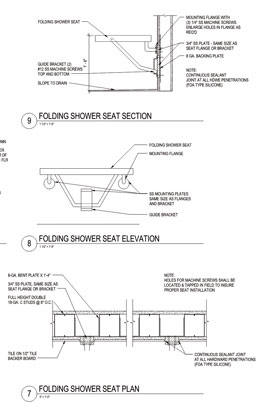Durability, ADA are shower seat considerations
 The drawings above show the proper mounting of shower seats to meet ADA requirements, as well as to improve durability of the construction. (CANCO graphic)
The drawings above show the proper mounting of shower seats to meet ADA requirements, as well as to improve durability of the construction. (CANCO graphic)
4 years, 11 months ago
By Ellen McCulley, AIA, LEED AP, NCARB
Nelson Design, Inc.

The Americans with Disabilities Act (ADA) was originally signed into law on July 26, 1990 and is applicable nationwide. The Department of Justice published revised regulations for Titles II (Standards for State and Local Governments) and III (Standards for Public Accommodations and Commercial Facilities) of the Standards for Accessible Design on September 15, 2010.
Section 213.3.6 of the 2010 ADA requires that where bathtubs or showers are provided, at least one that is ADA accessible must be installed. The ADA offers three options for shower compartments, which includes a standard roll-in shower, an alternate roll-in shower, and a transfer type shower. For both the standard roll-in and alternate roll-in types, shower seats are only required when used in transient lodging guest rooms. Shower seats are always required in a transfer type shower compartment.
The design of an accessible shower must be carefully planned due to the many code required dimensional limitations on the placement of the elements within. Each component must be thoughtfully located in order to meet requirements, without creating a conflict for another element. For example, the required grab bar lengths in a standard roll-in and alternate roll-in shower vary based on whether or not a (typically optional) shower seat is installed. When present, the grab bars cannot extend above the shower seat.
The ADA requires that the seat, fastener, mounting device, and supporting structure be able to withstand a horizontal or vertical force of a minimum of 250 pounds. Carl A. Nelson & Company uses and recommends a design threshold of 400 pounds in order to ensure the seat will withstand the heavy point force being applied to it. We have seen many instances of shower seats falling off the wall or tile around the seat being damaged due to a poorly detailed and/or executed design.
Typically shower walls are comprised of metal studs, cement board, and tile, which are not capable of sustaining repeatedly high point loads and coming away unscathed. One detail we have used successfully in the wall behind the shower seat is incorporating bent plate support members that are placed in between the studs and welded to them. This makes it very rigid and greatly reduces deflection in the wall when a point load is externally applied. Then stainless steel plates that are the same size as the shower seat flanges or brackets are welded to the bent plates at the shower seat support points. The tile, or other finishing material, is then cut around the stainless-steel component in order to avoid cracking.
By using the aforementioned detail, or a similar one, our customers are assured safety for the users as well as eliminating maintenance issues. If you have questions concerning this, or any other related code matter, please don’t hesitate to contact me.
About the Author
Ellen McCulley graduated magna cum laude with a Bachelor of Architecture degree from Iowa State University, where she received the Pella Architectural Award from the Department of Architecture in the College of Design. She is a registered architect in Iowa, Illinois, Nebraska and Missouri, and joined Nelson Design, Inc., a wholly owned subsidiary of Carl A. Nelson & Company, in 2012. Have code questions? Ellen can be reached at (319) 754-8415, or by email at canco@carlanelsonco.com. Readers can view past installments of Decoding the Code on our website.